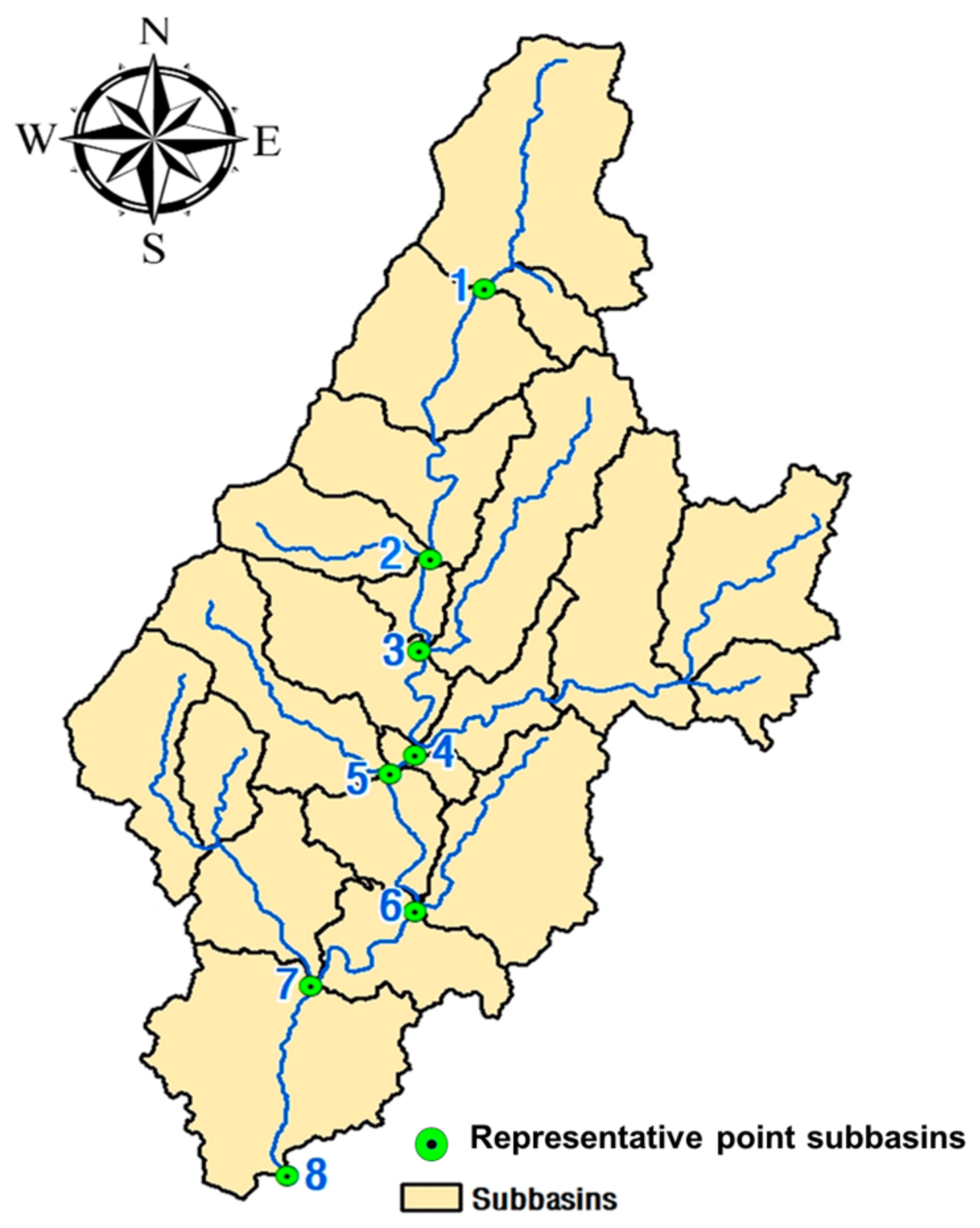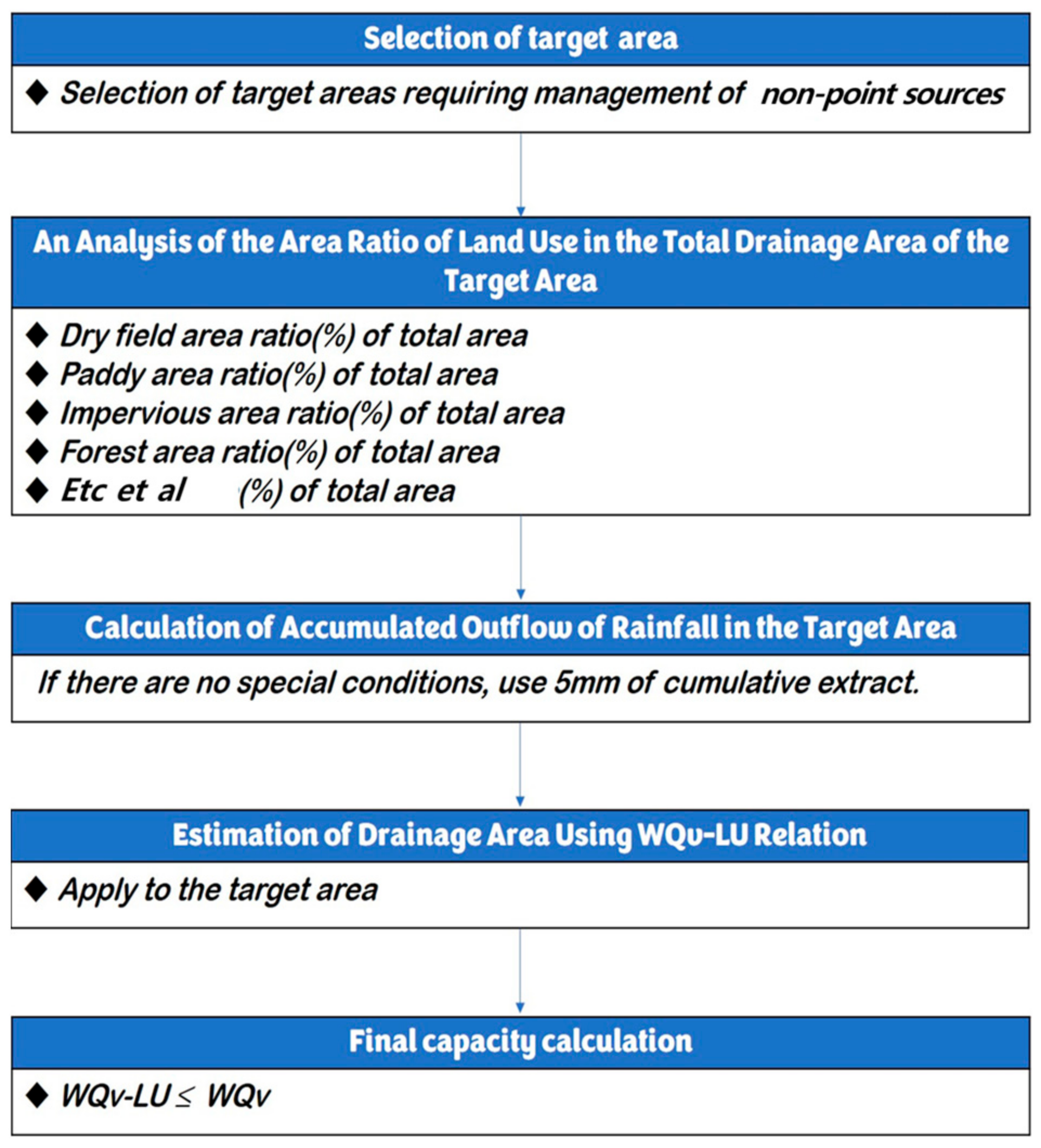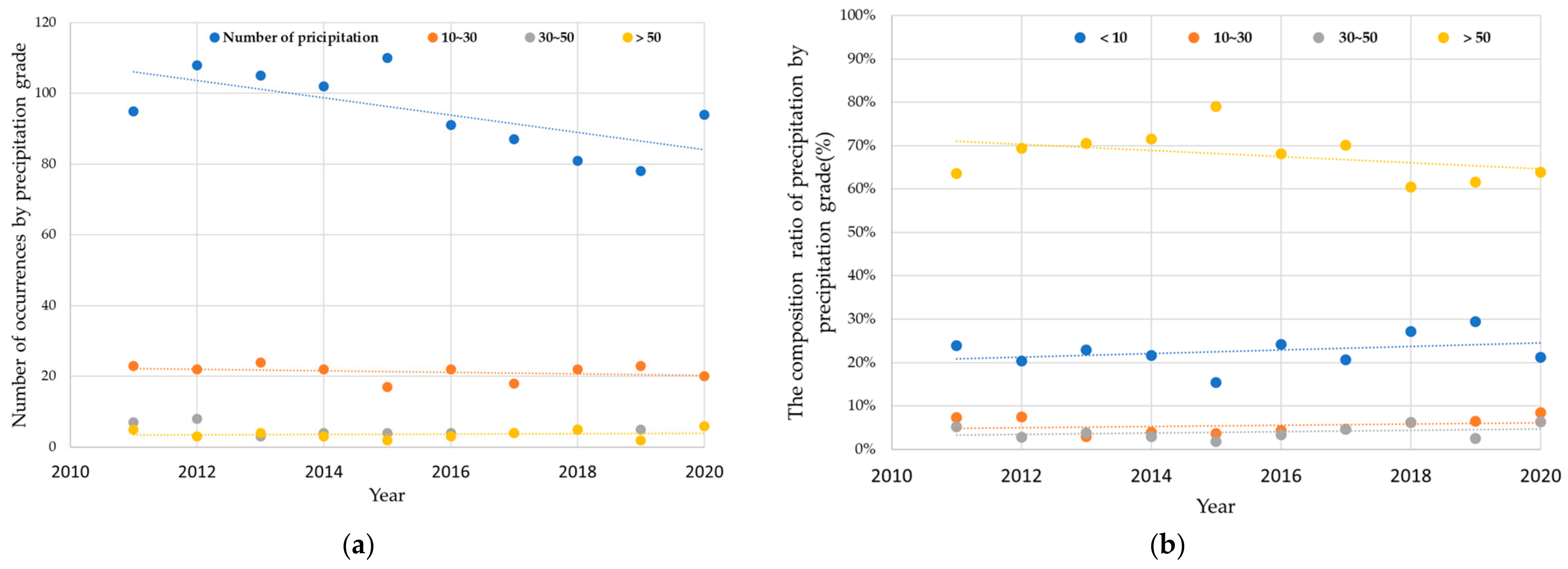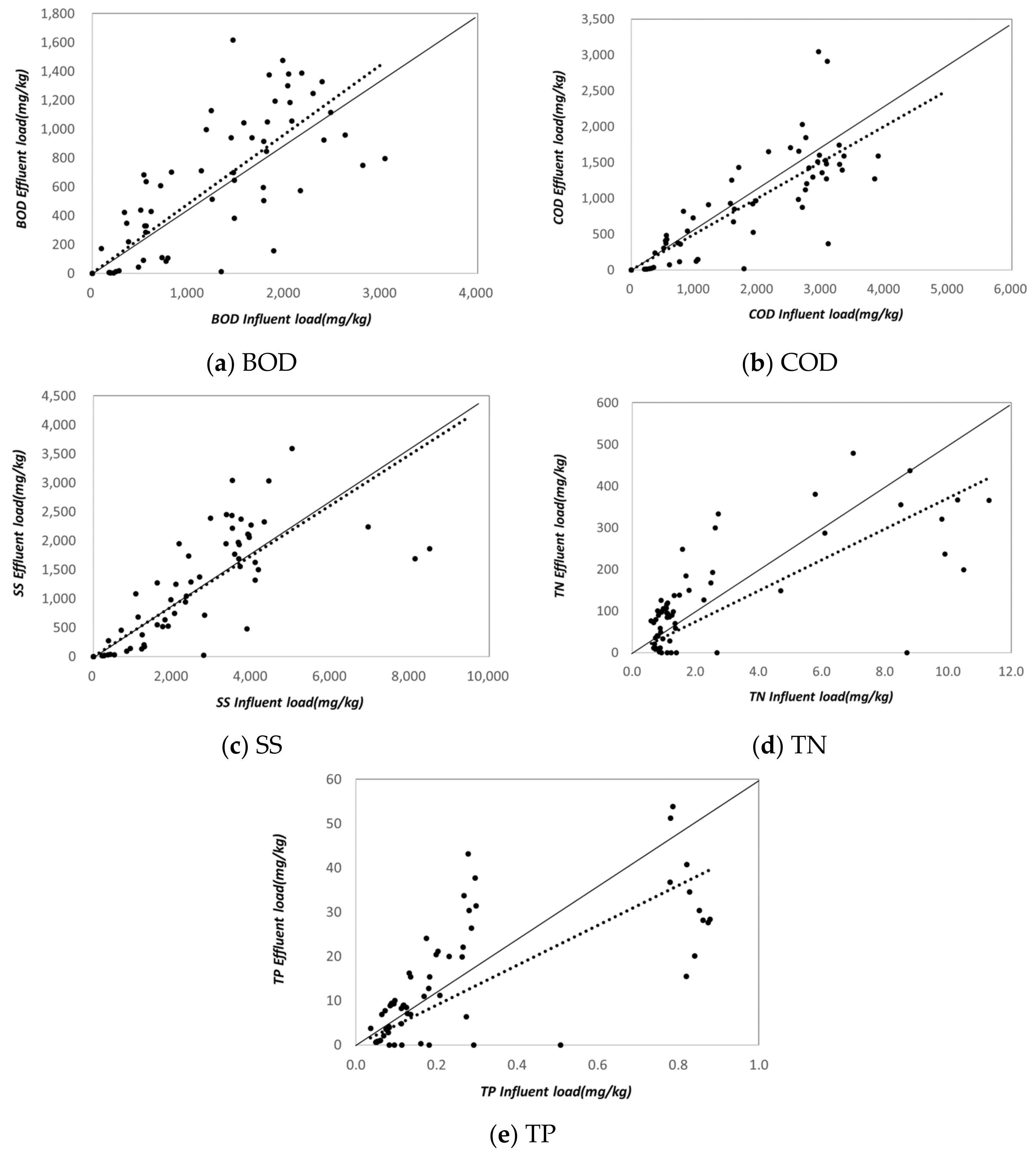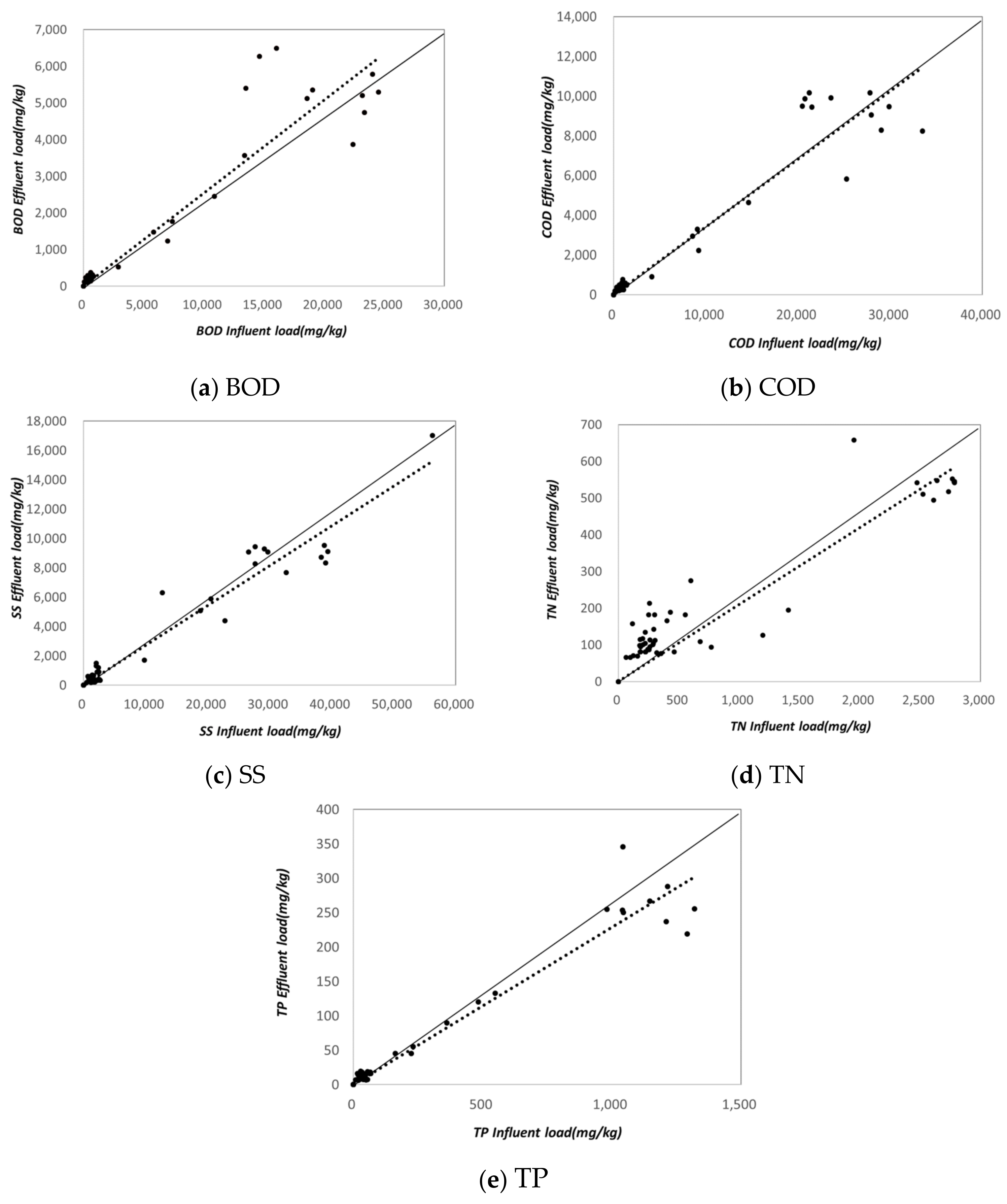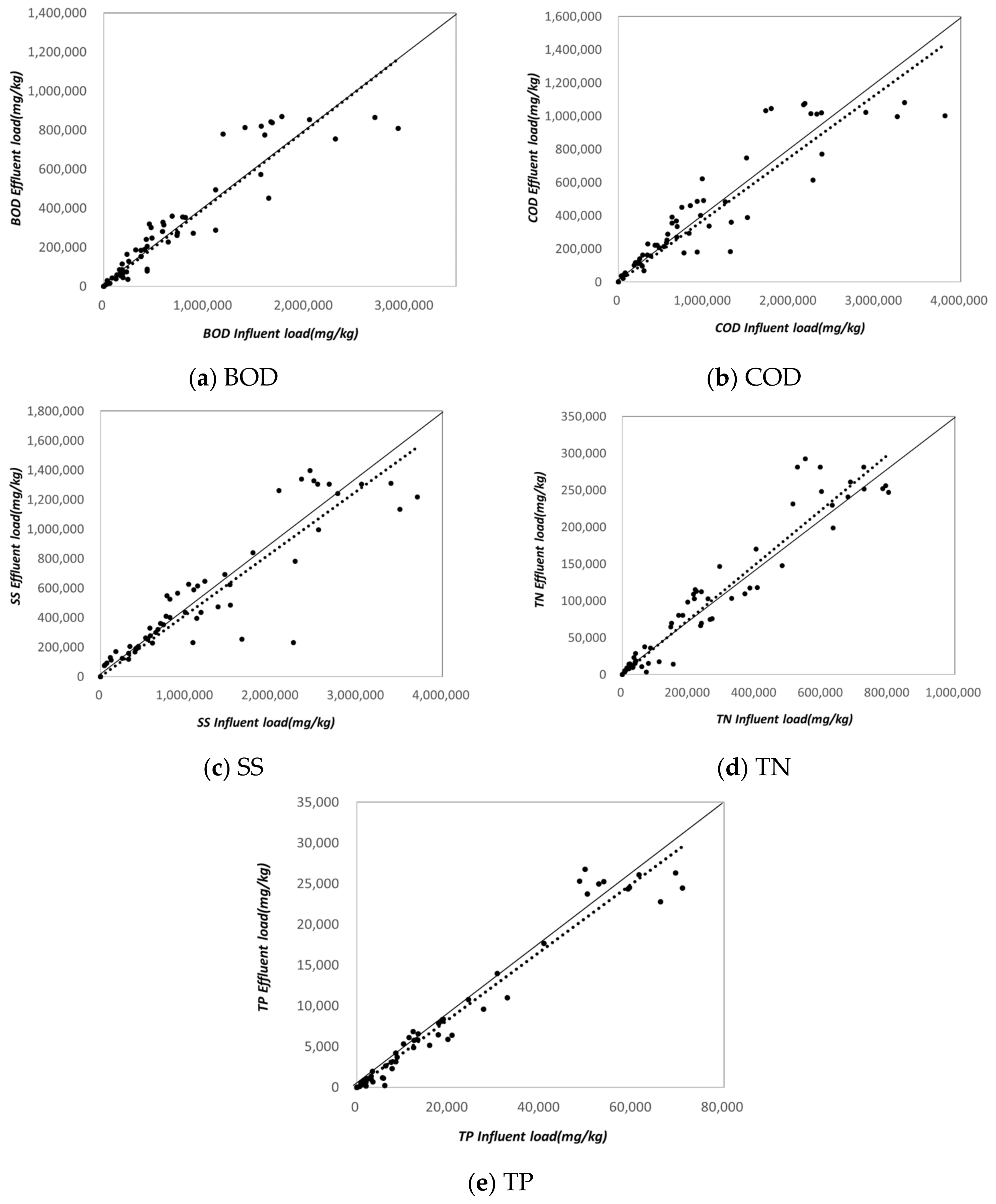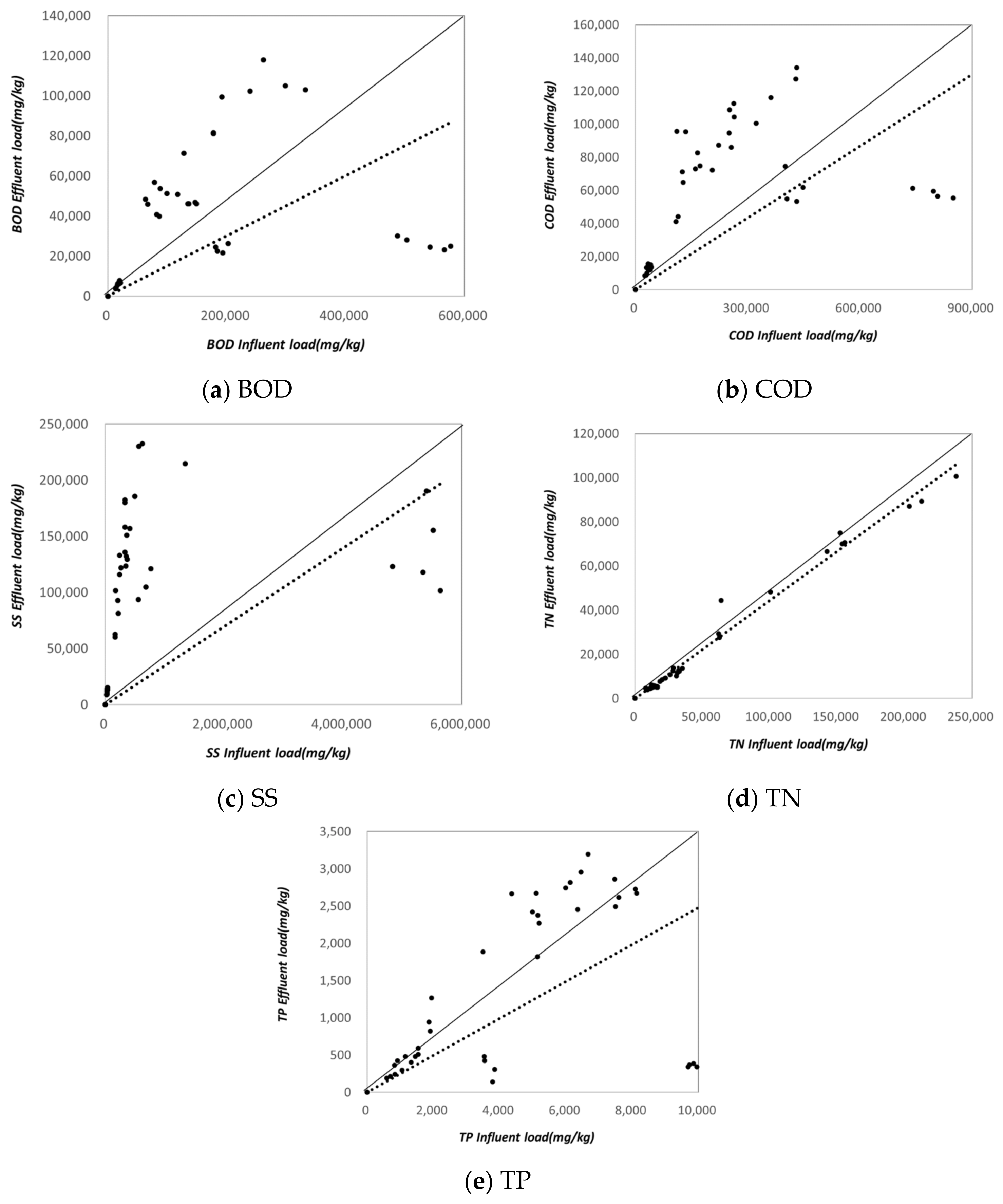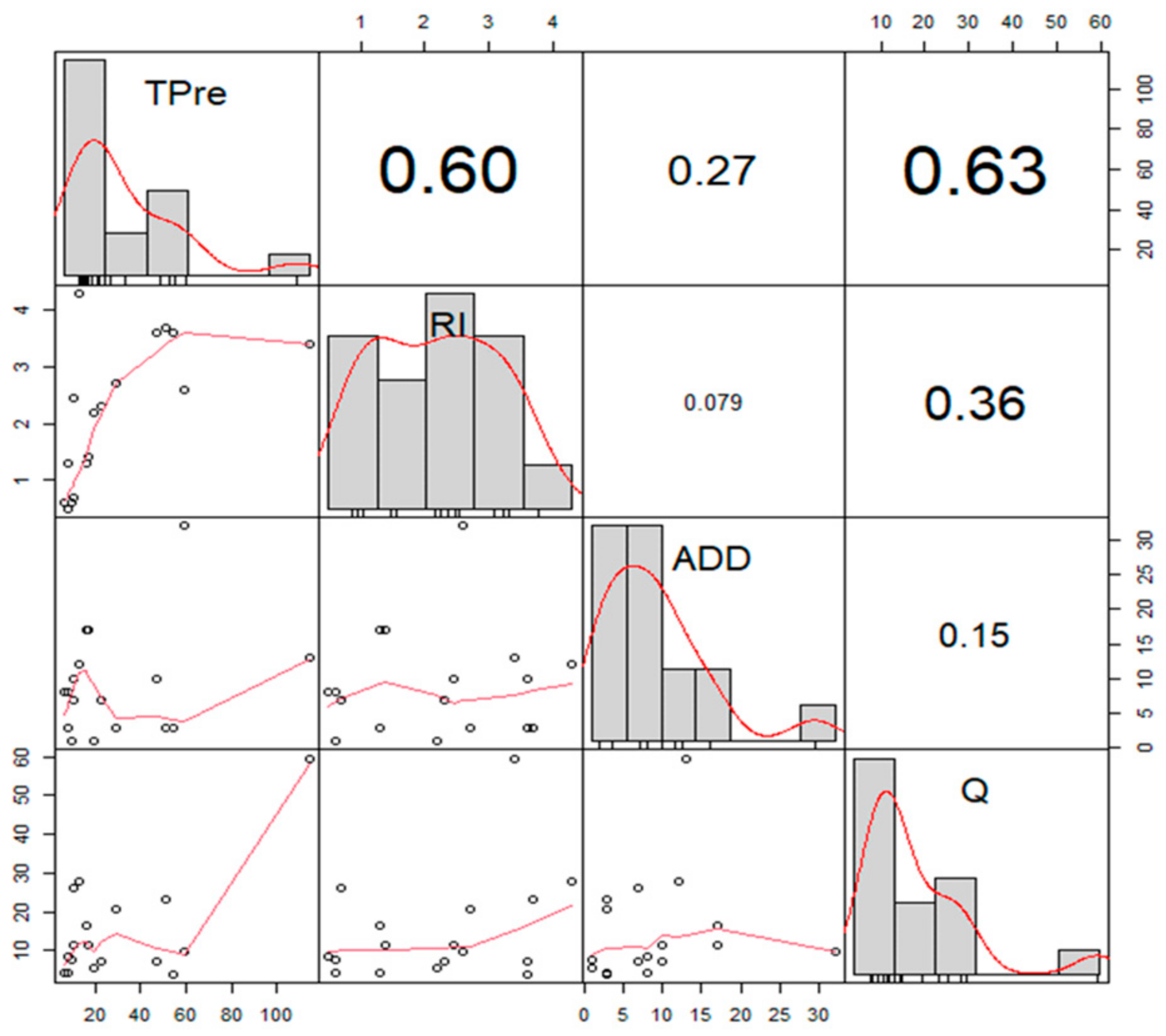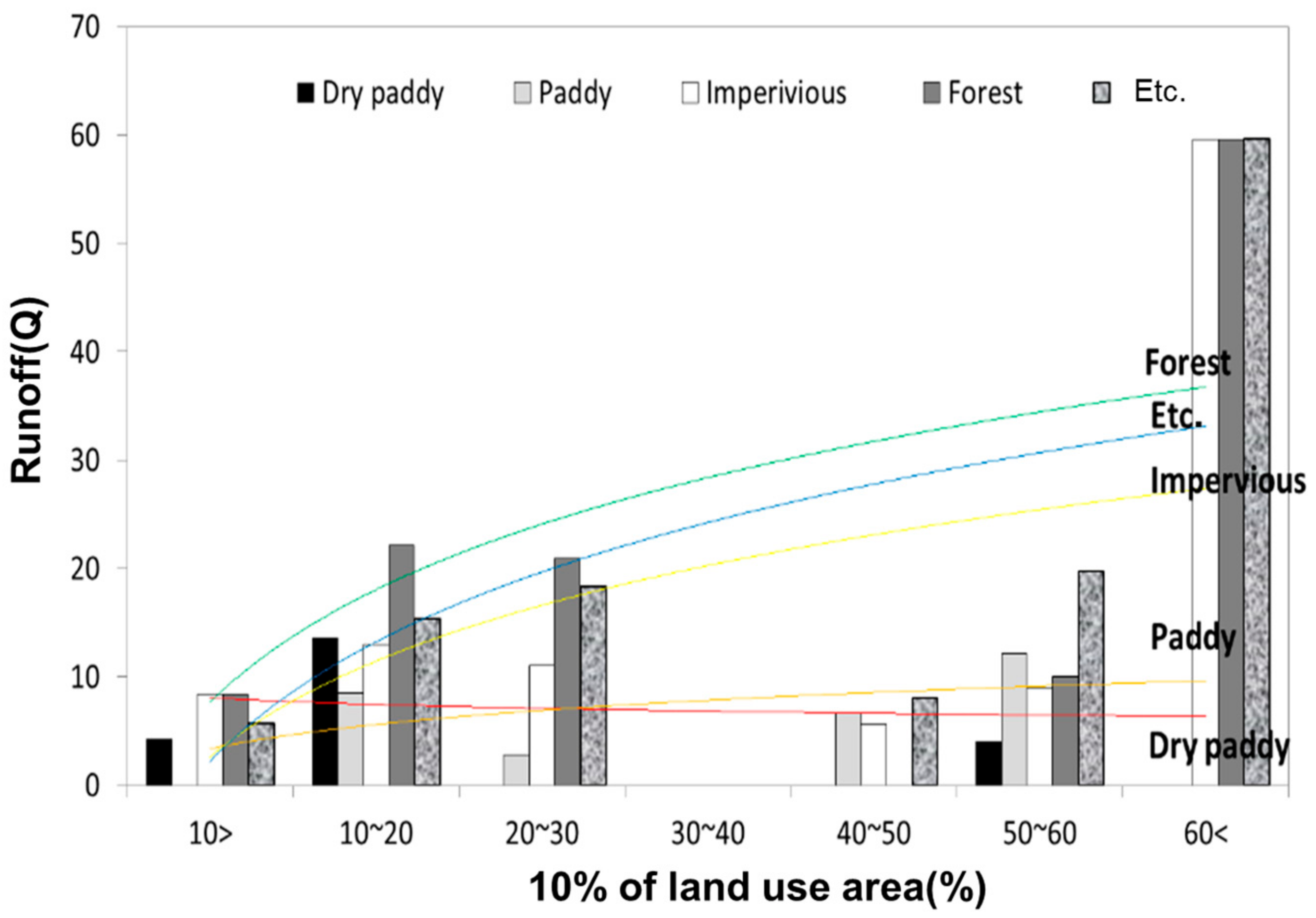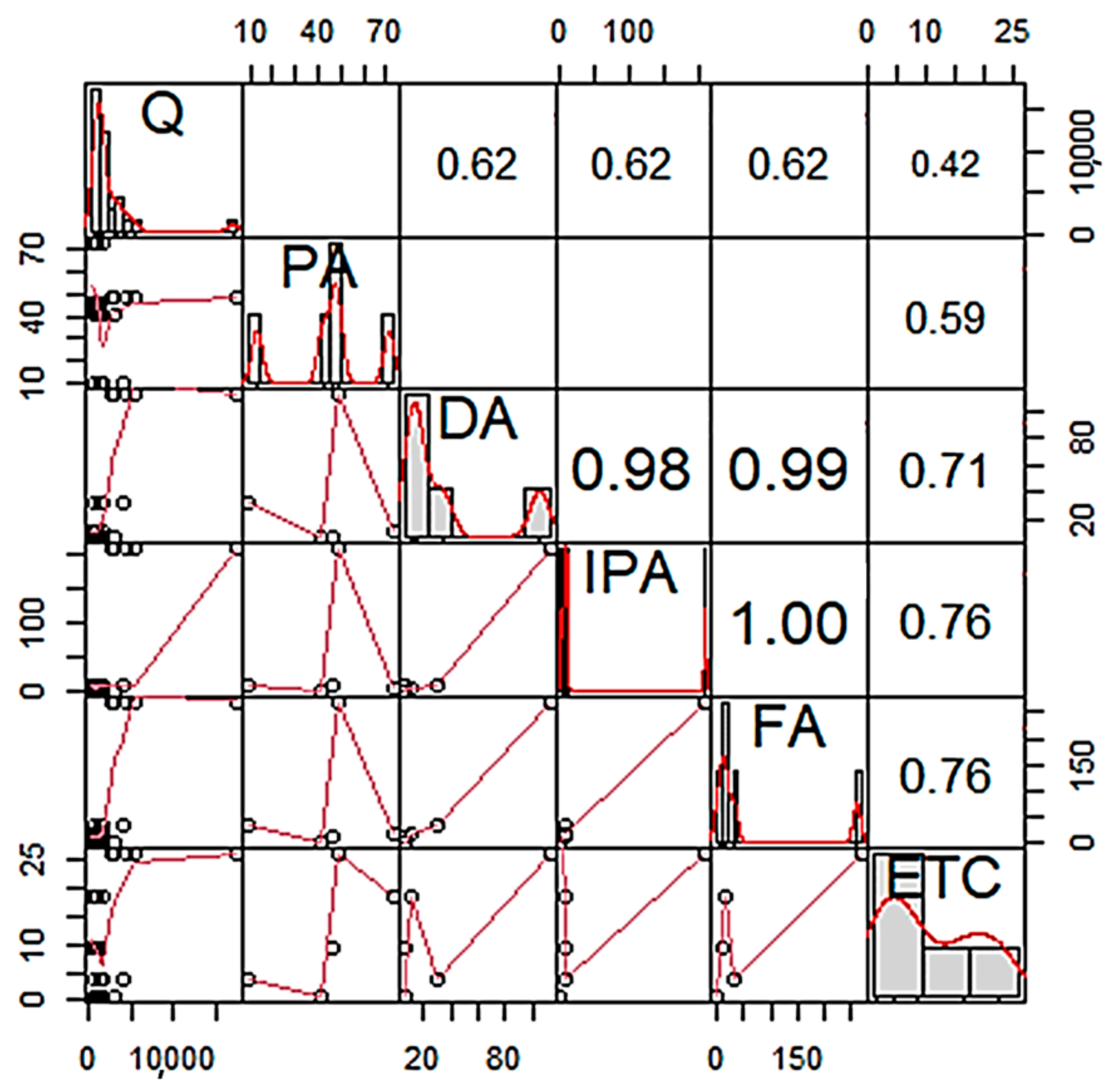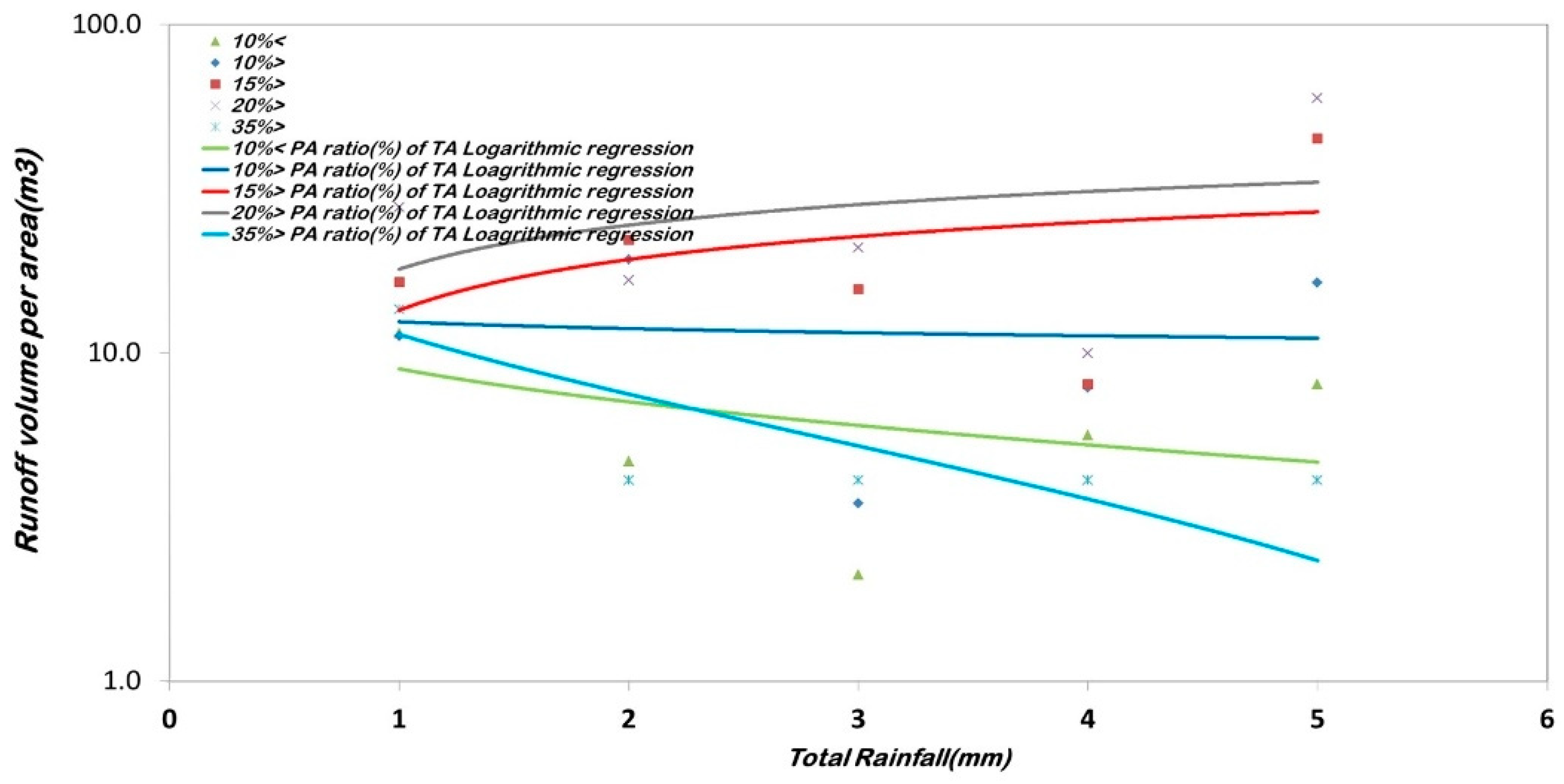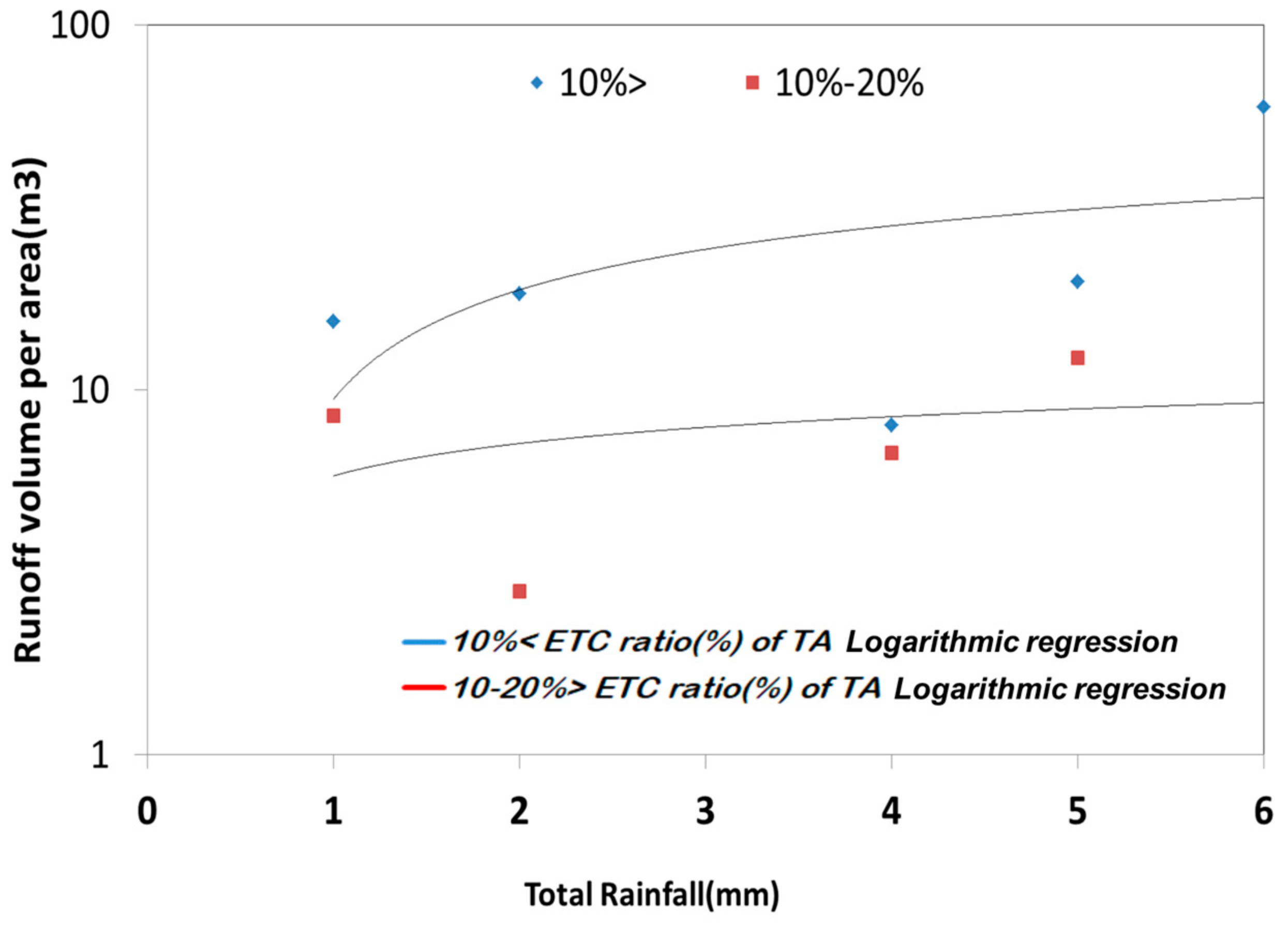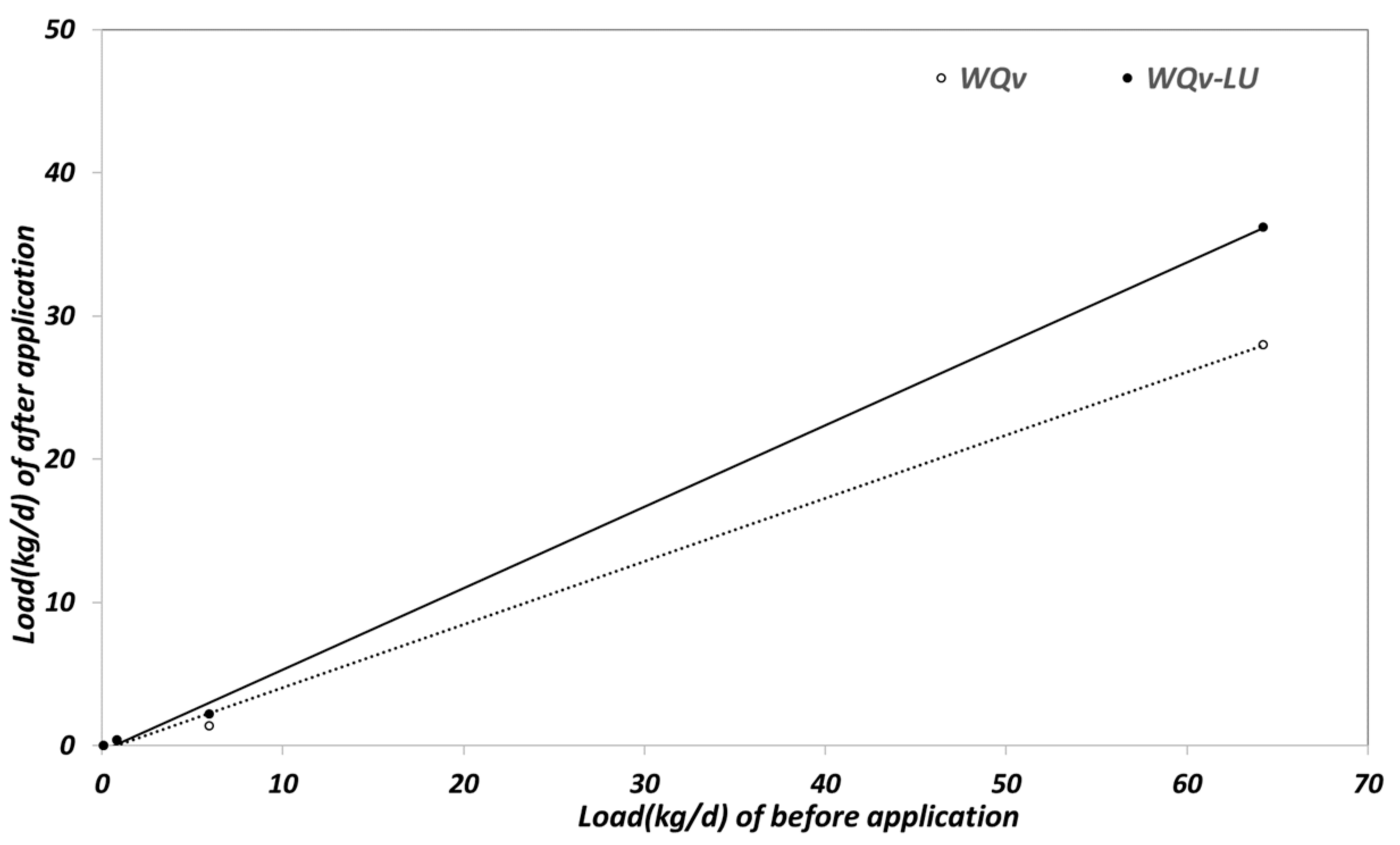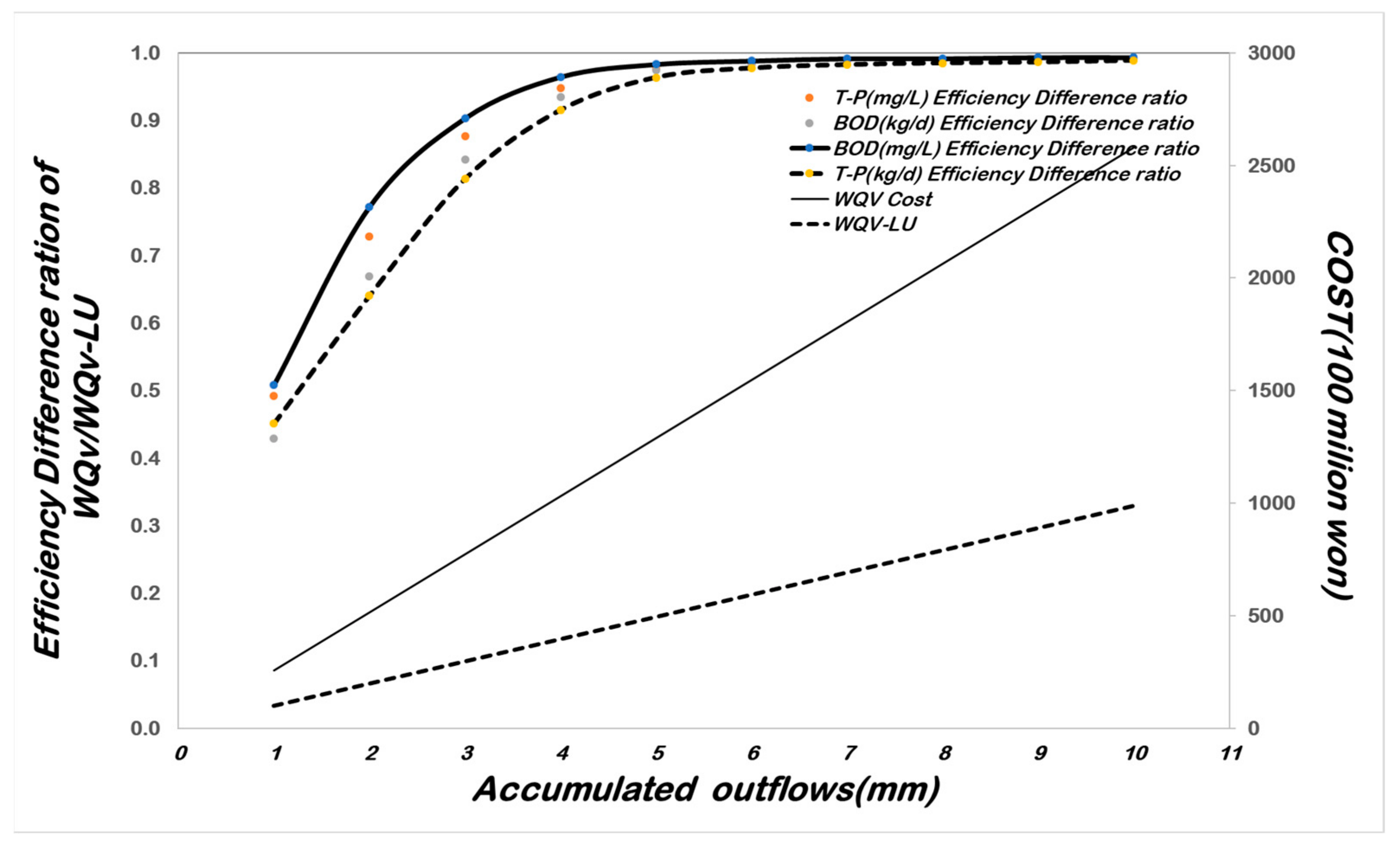3.1. Monitoring Results
Rainfall trends over the past three years were analyzed using data from weather observation stations in the five study areas. The study regions exhibited the highest annual frequency of 10–30 mm rainfall events, rather than events exceeding 50 mm. However, while the total annual rainfall showed a decreasing trend, the frequency of rainfall events exceeding 50 mm has been increasing since 2015.
Unlike total rainfall, the frequency of 10–30 mm rainfall events and those exceeding 50 mm demonstrated an inverse relationship in their fluctuations. Due to the increasing unpredictability of rainfall trends caused by climate change, the challenges associated with non-point source pollution and its management have become increasingly significant, as shown in
Figure 3.
The five study sites all exhibit characteristics of rural areas, particularly with paddy fields and dry fields covering a larger area than developed land. Accordingly, the non-point source pollution reduction facilities in each study site function as nature-based facilities with retention capabilities. These facilities, including constructed wetlands and retention basins, are primarily operated to manage organic pollutants such as agricultural runoff and pesticides from farmland in rural areas.
The total drainage area across the five study sites averaged 203.03 ha. As shown in
Table 5, the average land cover distribution was as follows: paddy fields (43.7 ha, 42.1%), dry fields (33.5 ha, 16.4%), developed land (47.62 ha, 12.9%), forested areas (66.52 ha, 21.5%), and other land types (11.69 ha, 7.2%). The analysis indicated that the proportion of agricultural land, particularly paddy and dry fields, was relatively high.
According to
Table 6, the pollutants generated in Area A are planned to be collected and directed into the system at the discharge outlet within the site by installing an overflow weir and screening facilities. The pollutants from agricultural complex are planned to be collected at the discharge outlet of the complex and directed into the system. Additionally, to maintain a certain water level in the constructed wetland and prevent the wilting of planted vegetation due to summer droughts and evaporation, it is planned to directly intake and utilize water from the nearby Yongsulcheon Stream.
The land use status of Area B consists of a total target area of 125.7 ha, comprising 73.1 ha of dry fields, 11.2 ha of paddy fields, 16.2 ha of forest, 6.6 ha of residential land, and 18.6 ha of other land uses. Among the land uses in the watershed, dry and paddy fields account for approximately 67% of the total area, indicating a high proportion of agricultural land. The non-point source pollutants generated in the upstream area of Area B are planned to flow along the Jukrimcheon Stream and be directed into the artificial wetland near the collection point by a movable weir. Additionally, it is planned to directly intake and utilize water from the nearby Jukrimcheon Stream.
The land use status of Area C consists of a total target area of 87.87 ha, including 32.81 ha of residential land, 40.36 ha of agricultural land, 4.00 ha of other land uses, and 10.70 ha of forest. Within the watershed, agricultural land accounts for approximately 45.93% of the total area. In Area C, the artificial wetland is designed to receive runoff water collected through collection facilities and an inflow pumping station. The water will then sequentially pass through a sedimentation pond, a shallow wetland, a deep wetland, another shallow wetland, and a final sedimentation pond before being discharged into the Juksancheon Stream.
Area D has a drainage area equivalent to that of a nearby lake, and an artificial wetland was designed to reduce the need for treatment ponds, utilizing natural purification techniques before inflow into the lake. A key characteristic of this watershed is that it consists mostly of impervious surfaces and has an extensive agricultural hinterland.
Area E is a unique region where stormwater pipelines and the surrounding urban and rural environments are significantly influenced, with more than 50% of the area consisting of forested land. Due to sediment blockage issues caused by forested areas, an underground storage tank was designed to address this problem.
Area A, where an artificial wetland has been installed, experienced six rainfall events, with total rainfall ranging from 11.0 mm to 51.5 mm. The rainfall duration varied between 4 and 14 h, and the average rainfall intensity was recorded between 1.4 mm/h and 3.6 mm/h. The antecedent dry period for all events was analyzed to be at least three days.
The average influent water quality was measured as BOD 14.3–16.1 mg/L, COD 19.7–23.8 mg/L, TOC 3.7–8.2 mg/L, SS 23.4–41.3 mg/L, TN 2.31–2.37 mg/L, and TP 0.18–0.29 mg/L. The average effluent water quality was recorded as BOD 11.2–12.5 mg/L, COD 14.6–23.7 mg/L, TOC 3.0–6.7 mg/L, SS 19.9–29.8 mg/L, TN 0.99–2.04 mg/L, and TP 0.08–0.12 mg/L, as shown
Figure 4.
The average influent water quality of the artificial wetland in Area B was measured as BOD 7.2–8.6 mg/L, COD 14.2–14.3 mg/L, TOC 3.9–14.6 mg/L, SS 19.9–22.3 mg/L, TN 4.23–5.15 mg/L, and TP 0.14–0.30 mg/L. The average effluent water quality was analyzed as BOD 4.1–9.2 mg/L, COD 8.2–13.9 mg/L, TOC 3.2–11.0 mg/L, SS 12.6–21.4 mg/L, TN 2.78–3.06 mg/L, and TP 0.09–0.13 mg/L.
The artificial wetland in Area B was monitored twice until June 2020. The EMCs (Event Mean Concentrations)of inflow and outflow pollutants calculated from the monitoring data were as follows. Influent EMCs were BOD 8.1 mg/L, COD 14.4 mg/L, TOC 9.3 mg/L, SS 21.4 mg/L, TN 4.65 mg/L, and TP 0.22 mg/L. Effluent EMCs were BOD 6.6 mg/L, COD 11.1 mg/L, TOC 6.9 mg/L, SS 17.1 mg/L, TN 2.92 mg/L, and TP 0.11 mg/L. In
Figure 4, the solid line represents an R
2 value of 1, while the dashed line represents the R
2 value for the respective substance. The R
2 value for TP is higher than that of the other substances, indicating that the efficiency of TP is relatively higher.
Despite heavy rainfall, the low concentration of influent water is attributed to missing the initial runoff inflow from the drainage area during monitoring. According to
Figure 5, the efficiency of pollutant load reduction in the Juksancheon watershed facility in Anseong City showed a high correlation coefficient, with most R
2 values exceeding 0.9 for different parameters. Particularly, SS exhibited the highest efficiency, which can be attributed to the characteristics of the Juksancheon watershed, where a high proportion of farmland and forested areas contribute to the drainage area. Thus, the results reflect the characteristics of the runoff water entering the system.
The average influent water quality of the artificial wetland in Area C was measured as BOD 3.4–9.4 mg/L, COD 5.1–19.8 mg/L, TOC 3.1–3.4 mg/L, SS 7.4–33.9 mg/L, TN 1.04–2.20 mg/L, and TP 0.09 mg/L. The average effluent water quality was analyzed as BOD 1.2–3.0 mg/L, COD 2.7–6.5 mg/L, TOC 2.8–3.1 mg/L, SS 5.7–9.5 mg/L, TN 0.36–0.63 mg/L, and TP 0.02–0.03 mg/L.
The overall average influent concentrations were recorded as BOD 6.3 mg/L, COD 12.5 mg/L, TOC 3.2 mg/L, SS 20.5 mg/L, TN 1.66 mg/L, and TP 0.09 mg/L, while the corresponding effluent concentrations were BOD 2.2 mg/L, COD 4.6 mg/L, TOC 3.0 mg/L, SS 7.6 mg/L, TN 0.48 mg/L, and TP 0.03 mg/L. According to
Figure 4, the efficiency of pollutant load reduction in the Area C facility showed a high correlation coefficient (R
2 > 0.9) for most parameters, indicating a strong relationship between influent and effluent quality. Notably, TN and TP reduction efficiencies were higher compared to other regions, as shown
Figure 6. This characteristic is likely due to the Wangsong Lake watershed, where the proportion of farmland is significantly high. The results suggest that organic matter from agricultural activities adheres to soil particles and is washed into the water system during rainfall events, contributing to the observed pollutant reduction trends.
Based on the monitoring results of the Seohyeon-ro detention facility in Seongnam-si, removal efficiencies were analyzed as followsBOD 75.0%, COD 72.5%, TOC 87.4%, SS 77.5%, TN 58.6%, and TP 76.5%. In
Figure 6, the solid line represents an R
2 value of 1, while the dashed line represents the R
2 value for the respective substance. Unlike the other four study sites, relatively low R
2 values were observed for each parameter. Notably, SS, which is the primary target of detention facilities, showed the lowest correlation, suggesting that more detailed monitoring considering rainfall-related factors such as antecedent dry days is necessary. However, as shown in
Figure 7, the facility was designed based on an influent BOD concentration of 34%, and the monitoring results meet the established design criteria.
3.2. Correlation Analysis for Deriving the Appropriate Capacity Estimation Equation
An analysis was conducted on the correlation between facility outflow volume and relevant influencing factors. First, the relationship between total precipitation and total outflow was examined. The results indicated that total precipitation (Tpre) had a significant impact on outflow (Q), with R2 = 0.630 and p-value < 0.05. This confirms that precipitation significantly affects outflow volume.
Additionally, rainfall intensity (RI) also exhibited a significant influence on outflow, with R2 = 0.600 and p-value < 0.05. Thus, it was observed that as precipitation and rainfall intensity increased, outflow volume also increased.
On the other hand, antecedent dry days (ADDs) showed a relatively low correlation with total precipitation, with R2 = 0.270. In other words, no positive or negative correlation was found between ADDs (the dry period preceding rainfall) and total precipitation.
As shown in
Figure 8, the histograms of total precipitation and rainfall intensity exhibit a similar trend to that of outflow volume, further supporting these findings.
An analysis was conducted on land use, area ratio, and runoff volume in relation to precipitation.
Figure 9 presents a graph analyzing runoff based on land use area ratio. The results showed that land use classification produced varying outcomes. However, when the utilization ratio of each land use type was below 20% of the total area, runoff was observed. When the utilization ratio ranged from 20% to 30%, runoff occurred from fields, rice paddies, residential areas, and forests. However, when the utilization ratio exceeded 50%, runoff was observed only from fields.
These findings indicate that total runoff volume varied depending on the land use ratio within the total area. Therefore, the land use ratio can be considered an influencing factor in determining runoff volume.
When the land use ratio was below 10% of the total area, runoff occurred in a diverse manner. Therefore, runoff volume was analyzed based on different rainfall classifications within this below-10% range, where the most data could be obtained.
Figure 10 illustrates the runoff volume categorized by land use type according to different rainfall ranges. Rainfall intensity was classified into the following categories: less than 10 mm, 10–20 mm, 20–30 mm, 30–40 mm, 40–50 mm, 50–60 mm, and above 50 mm.
The results indicate that as rainfall classification increased, runoff volume also increased in the order of forests, miscellaneous land, and residential areas. However, the runoff volume from rice paddies and fields showed a relatively lower increase compared to forests, miscellaneous land, and residential areas.
At this point, residential areas exhibited faster runoff rates compared to other land use types, whereas forests and miscellaneous land, due to their permeable surfaces, tended to retain water before runoff occurred. This trend aligns with previous studies, which demonstrated that as total precipitation increased, runoff from these land types occurred more gradually [
20].
These findings confirm that even under the same drainage area and rainfall conditions, the characteristics of runoff vary depending on land use type. Furthermore, different rainfall classifications exhibit distinct runoff patterns, highlighting the diverse nature of runoff behavior based on land use.
Thus, the variation in runoff volume occurring in the drainage area during rainfall was identified based on the land use area ratio. To analyze the correlation, a correlation analysis was conducted between the land use area ratio and the runoff volume during rainfall.
As shown in
Figure 10, the variables that exhibited the strongest correlation with runoff volume were fields (DA), residential areas (IPA), and forests (FA), with R
2 = 0.62 and
p < 0.05, indicating statistical significance. In contrast, rice paddies (PA) and miscellaneous land (ETC) showed a moderate correlation, with R
2 = 0.42 and
p < 0.05, also indicating statistical significance.
However, as shown in
Figure 11, rice paddies retain irrigation water, which delays runoff during rainfall events. Due to this characteristic, no negative correlation was observed, as the stored irrigation water prevents immediate runoff.
3.3. Equation for Estimating Optimal Capacity
A regression analysis was conducted to derive a regression model that explains the relationship between land use area ratio and runoff volume. To determine the most suitable model, the stepwise selection–elimination method was applied, with variables selected based on their statistical significance while minimizing the Akaike Information Criterion (AIC) to penalize model complexity.
As a result, the final runoff regression model was derived, as presented in Equation (8), demonstrating a high explanatory power (R2 = 0.965).
Additionally, the residual analysis confirmed that the model satisfied the three key assumptions of normality, homoscedasticity, and independence.
where DA: dry field area percentage (%)—PA: paddy area percentage (%)—IPA: impervious area percentage (%)—FA: forest area percentage (%)—ETC: other land use percentage (%).
This regression equation represents the relationship between land use percentages and runoff volume (Q). The coefficients indicate the impact of each land use type on runoff, with impervious areas (IPA) contributing the most positively to runoff, while paddy fields (PA) and other land uses (ETC) show a negative correlation.
Among all land use types, residential areas (IPA) and miscellaneous land (ETC) exhibited the highest correlation coefficients with runoff volume. This result indicates that as the impervious surface area increases, the runoff volume requiring management also increases during rainfall events.
On the other hand, fields (DA) showed a negative correlation, meaning that an increase in the area of rice paddies did not correlate with an increase in runoff volume.
These findings suggest that the type and quantity of pollutants in runoff vary depending on land use characteristics.
In recent years, awareness of the importance and challenges of non-point source pollution has grown, leading to the exploration of various mitigation strategies. When applying control facilities, differences arise depending on land use type, surface sediment accumulation, rainfall amount, and rainfall intensity. As a result, the importance of on-site monitoring has been increasingly recognized [
21,
22].
Therefore, this study is considered highly reliable, as it reflects the results of field-monitored data.
In particular, non-point source pollution control facilities were installed to reduce the pollutant load discharged during the initial rainfall. As a result, the facility-specific monitoring conducted in this study provides insight into pollutant concentrations during the early stages of rainfall runoff.
The initial rainfall is known to exhibit relatively high pollution levels compared to the total precipitation. This phenomenon is attributed to the first flush effect, and the characteristics of rice paddies as a land use type appear to have influenced the observed results. This is because rice paddies have a relatively shorter time of concentration when discharging into rivers but exhibit a lower runoff rate compared to impervious surfaces such as residential areas [
23].
An analysis of runoff volume based on rainfall classification was conducted for five study areas according to total precipitation levels.
As shown in
Figure 12, when the proportion of rice paddies exceeded 20% of the total area, runoff volume began to decrease at a total rainfall of 15–20 mm. However, when the total precipitation exceeded 50 mm, the runoff volume increased.
According to the Technical Guidelines for Total Water Pollution Load Management [
24], floodgate management for crop cultivation can be applied to reduce non-point source pollution loads. In particular, research by the National Institute of Agricultural Sciences [
25] reported that proper installation and management of drainage floodgates reduced runoff by 33.8%. Additionally, monitoring data from the Agricultural Environmental Conservation Project [
26] indicated that floodgate management significantly reduced phosphorus levels in runoff.
Therefore, in the study area, the influence of floodgates may have affected early rainfall runoff, and runoff generation was observed when precipitation exceeded 50 mm.
When applying the derived correlation equation, it is valid for areas where rice paddies constitute at least 20%of the total land area. However, for rainfall exceeding 50 mm, the application of this formula may be limited. If rainfall conditions fall outside this range, additional water quality monitoring and watershed modeling should be conducted to develop more precise equations.
Nevertheless, since the empirical formula was derived based on field monitoring data from drainage areas where non-point source pollution reduction facilities are in operation, it is expected to be suitable for application in rural areas of South Korea [
27,
28].
Additionally, as shown in
Figure 13, the proportion of miscellaneous land (ETC) in relation to rainfall classification was analyzed. Unlike rice paddies, the monitored proportion of miscellaneous land was 20%, as indicated in the legend of
Figure 13. It was observed that as the proportion of miscellaneous land increased, runoff volume also increased with increasing rainfall classification.
However, when the proportion of miscellaneous land was below 10%, runoff volume initially increased with higher total rainfall but began to decrease at 30–35 mm of precipitation. In contrast, when the proportion of forested areas was 10–20%, runoff volume sharply decreased at 15–20 mm of rainfall, followed by an increase at 30–35 mm.
As total precipitation increased, the runoff trend continued to rise in land use areas where the proportion ranged from 10 to 20%. Although runoff volume varied depending on the proportion of miscellaneous land in the study area, the overall trend showed an initial decrease at a certain precipitation level, followed by a continuous increase beyond that point.
In the proposed regression equation, miscellaneous land (ETC) exhibited a negative value, indicating that the equation is most suitable for cases where the proportion of miscellaneous land is below 20% and rainfall is less than 30 mm. Although this is an empirical equation derived from non-point source pollution monitoring, limitations may arise when applying it to areas with different conditions. However, if capacity estimation is performed based on land use characteristics and precipitation patterns, it is expected to enhance the efficiency of non-point source pollution management.
3.4. Appropriateness of the Optimal Capacity Equation
First, the area ratios for land use types such as rice paddies, fields, developed land, forests, and others were applied to both the WQv and WQv-LU equations. The resulting coefficients were then applied to the sub-watershed areas. The sub-watershed areas used in the analysis are shown in the
Table 7.
Water quality and pollutant load results were derived at Songya Point 8, the downstream confluence point of the sub-watersheds in the study area. The facility capacity was applied using the estimation equation developed in this study. As a result, the TP load at the downstream end of the Songya Point 8was found to decrease after facility implementation, as shown by the LDC (Load Duration Curve) analysis as shown
Figure 14.
In the flow management range of 10–60%, where non-point source pollution has the greatest impact in the Songya watershed, water quality improved by 50.3% for BOD and 67.0% for TP, while pollutant loads were reduced by 43.6% for BOD and 63.0% for TP, compared to the pre-application conditions. These results indicate that applying facility capacity using the proposed equation showed slightly lower improvement efficiency in water quality and pollutant load reduction compared to the WQv method. Specifically, WQv resulted in improvements of BOD 50.3%and TP 75.6%in water quality, and BOD 56.4%and TP 76.4%in pollutant load, demonstrating somewhat higher effectiveness than WQv-LU (Water Quality Volume–Land Use).
As shown in
Figure 14, although the cost associated with WQv was higher, the WQv-LU equation also achieved the target TP concentration of 0.2 mg/L within the 10–60% flow range.
As shown in
Figure 14, differences in pollutant load reduction resulting from the two capacity estimation equations were observed at the downstream 8 point in the Songya watershed, the location of which is presented in
Figure 1.
The validity of the proposed equation was evaluated by comparing it with the conventional Water Quality Volume (WQv) equation [
29,
30]. The results indicated that when the design was based on an accumulated runoff depth of 5 mm [
20,
22,
23], similar improvements in water quality and pollutant load reduction were observed [
2,
30,
31] (
Figure 15).
Table 8 presents a comparison between the WQv method and the WQv-LU equation proposed in this study, showing the ratio of efficiency between the two approaches. Since the comparison is based on a ratio [
32,
33], a value close to 1.0 indicates that the effectiveness of the two equations converges.
The results demonstrate that the WQv-LU equation converges with the WQv method when applied under the same area and rainfall conditions, particularly when the accumulated runoff depth exceeds 5 mm. Therefore, setting 5 mm as the reference standard for application is deemed appropriate.
Despite a reduction in total drainage area, the equation maintained similar pollutant load reduction efficiency, indicating its validity. However, as this equation is empirically derived, it may have limitations based on the specific characteristics of the study area. To enhance its applicability, further monitoring and validation across different study areas should be conducted.
Additionally, this equation incorporates a coefficient for drainage area extent, a key variable in capacity estimation. As a result, when estimating capacity in rural areas with a high proportion of permeable surfaces, this method provides a more detailed calculation based on land use area coefficients, rather than relying solely on impervious surface criteria used in urban WQv models.
From a cost perspective, the proposed equation also demonstrated significant cost savings compared to the WQv method. As shown in
Table 8 and
Figure 16, cost differences increased as accumulated runoff depth and capacity increased. At an accumulated runoff depth of 5 mm, the proposed equation resulted in a cost reduction of approximately KRW 79.5 billion.
The cost estimation for non-point source pollution control facilities is approximately KRW 170,000 per drainage area unit. Over the past three years (2018–2020), the average project budget for such facilities in the study area was approximately KRW 2 billion [
23]. The proposed equation allows for a 61.7% reduction in facility capacity estimation costs compared to the WQv method, as shown in
Table 8.
Thus, even under the same accumulated runoff depth conditions, the proposed WQv-LU equation achieves similar effectiveness beyond 5 mm, as shown in
Figure 16, while significantly reducing economic costs.
In this study, two capacity estimation equations were developed for determining the appropriate facility capacity, and both were found to be suitable.
First, the equations were evaluated by comparing and analyzing their results on stream water quality and pollutant loads against those obtained using previously established methods. Although the improvement effects were assessed to be lower than those of existing equations, the results may vary across different flow ranges, and the water quality met the required standards.
Second, the proposed equations offer cost-saving benefits. While showing comparable efficiency, the new equation allows for a more precise estimation of effective treatment area based on the proportion of land use within the drainage area. Since the final cost of non-point source pollution reduction facilities is determined based on site-specific conditions, the proposed equation presents an economic advantage in terms of cost efficiency.
